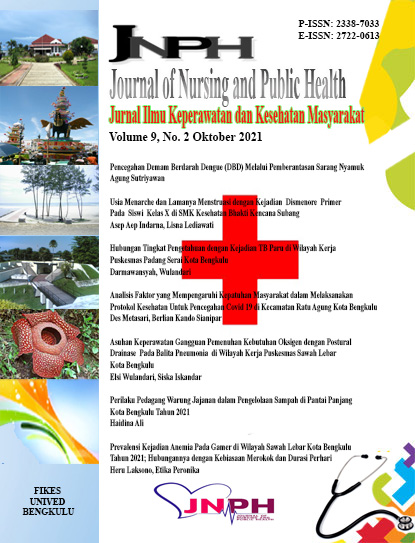PENGARUH IMPLEMENTASI 4 PILAR PENATALAKSANAAN DIABETES MELLITUS TERHADAP PENGETAHUANPADA PENDERITA DIABETES MELLITUS DI PUSKESMAS KANDANG KOTA BENGKULU
Abstract
Diabetes Mellitus (DM) merupakan penyakit kronis yang terjadi akibat pankreas tidak memproduksi cukup insulin. Komplikasi diabetes mellitus harus dicegah sedini. Penatalaksanaan diabetes mellitus dapat diperoleh secara efektif jika individu memiliki pengetahuan untuk melakukan perilaku pengelolaan DM. Tujuan penelitian ini untuk mengetahui pengaruh Implementasi 4 Pilar Penatalaksanaan Diabetes Mellitus terhadap pengetahuan pada pasien Diabetes Mellitus di Puskesmas Kandang Kota Bengkulu 2020.Desain penelitian adalah quasi eksperimental dengan pre-test and post- test with control group design. Jumlah sampel 50 orang terdiri dari 25orang kelompok intervensi dan 25 orang kelompok kontrol. Teknik sampling adalah purposive sampling. Pengetahuan menggunakan Instrumen SEDM yang terdiri dari 40 item. Analisis menggunakan t-test pada α < 5%.Hasil penelitian menunjukkan bahwa rata-rata nilai pengetahuan sebelum diberikanimplementasi 4 pilar penatalaksanaan diabetes mellitus pada kelompok intervensi adalah 4,44 dan rata-rata pengetahuan post adalah 8,04, sedangkan rata-rata pengetahuan pre pada kelompok kontrol adalah 4,12 dan rata-rata pengetahuan post adalah 6,28. Ada pengaruh implementasi 4 pilar penatalaksanaan diabetes mellitus terhadap nilai pengetahuan penderita diabetes mellitus(p value=0.000).Implementasi 4 pilar penatalaksanaan diabetes mellitusdapat meningkatkan pengetahuan pada pasien diabetes mellitus di Puskesmas Kandang Kota Bengkulu.Diharapkan pasien dan keluarga yang telah terpapar implementasi 4 pilar penatalaksanaan DM mampu mengaplikasikan terapi tersebut secara mandiri.
Downloads
References
Ariani, Y. (2011). Hubungan Antara Motivasi Dengan Efikasi Diri Pasien Dm Tipe 2 Dalam Konteks Asuhan Keperawatan Di Rsup. H. Adam Malik Medan. Magister Ilmu Keprawatan Kekhususan Keperawatan Medikal Bedah Fakultas Ilmu Keperawatan Universitas Indonesia..
Dinkes Bengkulu. (2019). Profil Kesehatan Bengkulu.
Hupfeld, C. J. & Olefsky, J. M. (2016). - Type 2 Diabetes Mellitus: Etiology, Pathogenesis, And Natural. Endocrinology: Adult And Pediatric (Seventh Edition)., Chapter 40.
Kejadian, F. R., Ginjal, G., & Ggk, K. (N.D.). Ruang Hemodialisa (Hd) Rsup H. Adam Malik Medan.
Kemenkes Ri. (2018). Riset Kesehatan Dasar; Riskesdas. Balitbang Kemenkes Ri.
Munir, N. W. (2020). Self-Efficacy Dan Kualitas Hidup Pasien Diabetes Melitus Tipe 2. Jurnal Penelitian Kesehatan Suara Forikes, 11.
Murdiningsih, D.S & Ghofur, G. G. . (2013). Pengaruh Kecemasan Terhadap Kadar Glukosa Darah Pada Penderita Dm Di Wilayah Puskesmas Banyuanyar Surakarta. Jurnal Talenta Psikologi, 2, 180–197.
Niddk. (2016). Kidney Disease Statistics For The United States. National Institute Of Diabetes And Digestive And Kidney Diaseases.
Rahayu, A. P. (2014). Pengaruh Edukasi Gizi Terhadap Pengetahuan, Sikap Dan Kadar Gula Darah Pasien Rawat Jalan Diabetes Melitus Tipe 2 Di Wilayah Kerja Puskesmas Kota Makassar.
Rondhianto. (2012). Keterkaitan Diabetes Self Management Education Terhadap Self Efficacy Pasien Diabetes Melitus. Jurnal Keperawatan, 216–229.
Who. (2016). Sustainable Development Global Solutions Network (Sdgs).
Wicaksono, R. P. (2011). Faktor-Faktor Yang Berhubungan Dengan Kejadian Diabetes Melitus Tipe 2 (Studi Kasus Di Poliklinik Penyakit Dalam Rumah Sakit Dr. Kariadi. Faculty Of Medicine.
Yunitasari, T. (2019). Efektivitas Edukasi Empat Pilar Penatalaksanaan Diabetes Melitus Terhadap Pengetahuan, Sikap, Dan Perilaku Pasien Prolanis. Jurnal Riset Gizi, 7.

An author who publishes in the Journal of Nursing and Public Health agrees to the following terms:
Author retains the copyright and grants the journal the right of first publication of the work simultaneously licensed under the Creative Commons Attribution-ShareAlike 4.0 License that allows others to share the work with an acknowledgement of the work's authorship and initial publication in this journal
Submission of a manuscript implies that the submitted work has not been published before (except as part of a thesis or report, or abstract); that it is not under consideration for publication elsewhere; that its publication has been approved by all co-authors. If and when the manuscript is accepted for publication, the author(s) still hold the copyright and retain publishing rights without restrictions. For the new invention, authors are suggested to manage its patent before published. The license type is CC-BY-SA 4.0.
Journal of Nursing and Public Health is licensed under a Creative Commons Attribution-ShareAlike 4.0 International License.
You are free to:
Share — copy and redistribute the material in any medium or format
Adapt — remix, transform, and build upon the material
for any purpose, even commercially.
The licensor cannot revoke these freedoms as long as you follow the license terms.









